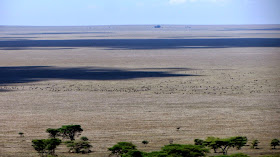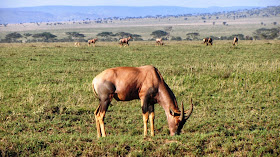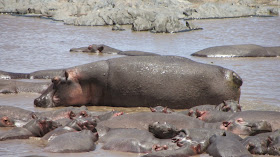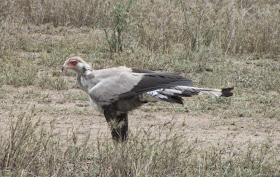 |
| The stunning Mwanza flat-headed rock agama |
 |
| Entering the land of the Masai |
My first introduction to it was through a book my dad bought me long ago - must have been more than a couple decades ago. I will have to check exactly when it was ordered next time I go home. The book bearing the same title was a pictorial depiction of the splendor of Serengeti and its great migration and left an indelible mark on my mind back then. No surprise then that it was one of the first things on my bucket list although the word wishlist seems more appropriate.
 |
| Hildebrandt's starling at the Naabi Hills gate |
Fast forward a couple decades to 2012 and I visited Kenya with my family and was lucky to witness the migration from the Kenyan side. After that, Serengeti wasn't up there at the top of the list anymore. After all Masai Mara on the Kenyan side and Serengeti on the Tanzanian side are part of the same ecosystem and the migration is a clockwise movement of the wildlife between the rich grasslands of Serengeti and the plains of the Masai Mara separated by the Mara River and the international boundary between these two dominant East African nations.
 |
| Serengeti is borrowed from the Masai word Seregit meaning "Endless Plains" and rightly so. Note the wildebeests |
 |
| My first sighting of the Serval |
 |
| Hartebeest |
As mentioned in my previous posts, my Tanzanian sojourn was just ten day and time was a luxury I didn't have. Climbing Mt. Kilimanjaro had to take precedence over anything else so Serengeti had to be dropped initially but when I saw the faint window of opportunity I got greedy. Surely I couldn't pass up the chance to go to Serengeti. Not now – not after having lived in African for almost 5 years and not when I was so close to it…and so Serengeti happened!
 |
| Breakfast of acacia leaves |
 |
| Topi on the plains of Serengeti |
The night after the safari in Tarangire was spent at Sunbright camp located in a small town called as “Mto wa Mbu” which translates as the “Place of the Mosquito River” in Swahili, presumably because in the past it was infested with malaria carrying mosquitoes. Sunbright camp had nice safari tents with attached bathroom which was nice because for the next three days we would be sleeping in more humble accommodation of a basic tent.
 |
| A herd of Impalas with the male |
 |
| Wildebeest crossing the road |
 |
| Itchy baboon |
Much like Masai Mara, the park entry is for 24 hours so Dennis was trying to time our entry such that we get two whole days in the park and have to pay for exactly two days. After entering the park gates we had to drive a further 30 odd minutes to reach Naabi Hill where the park dues we paid and the entry permits processed. While Dennis worked on the paperwork we ate our packed lunch and explored the nearby Kopje. The highlight was the strikingly beautiful agama lizard with its iridescent pink and blue colors which was different from the coloration of the ones that are so prolific in Liberia.
 |
| Vultures and Marabou Stork tearing into a wildebeest carcass |
 |
| Leopard tortoise crossing the road |
Soon after we officially entered the park we saw several zebras and wildebeests grazing on the plains and it felt like a mini-migration. Dennis, our driver and guide suggested that these animals must have been laggards or the ones who lost their way and having missed their migration to the Masai Mara in the north were now confined to the plains of Serengeti until the herds returned back south.
 |
| My first time staring into the eyes of a leopard |
 |
| Dik-Dik |
Normally the short rains begin around early November and by late November and December, the herds of the wildebeest migration arrive on the short-grass plains of the Serengeti. We were there in early October so in a normal year we wouldn't have much of a chance encountering the migration on the Serengeti side but things were seemingly different this particular year.
 |
| Egyptian goose really pushing its luck |
 |
| Testing their strength |
Justin and Holly informed me that their tour operator had told them that the short rains had arrived earlier by almost a month so there was a decent chance of seeing at least the early part of the migration as the herds start returning back earlier than the normal pattern of late November and early December. It had rained in Tanzania off and on while I was there so there was some merit to that thought. So…there was a distinct possibility I could get to see the great migration for a second time.
 |
| Zebra, Wildebeest and Giraffe in a single shot |
 |
| Lonely elephant |
They were pretty excited to see the migration and rightly so, but I wouldn't call myself desperate. Sure, I would love to see it again but to me just being in the Serengeti was a fortunate event and anything I see would be a welcome bonus. I would happily go back home regardless if I saw the migration or not.
Well, that was my thought on the exterior, deep down I really wished I could see a leopard. It's the only one of the Big Five that had evaded me thus far. It’s no doubt an elusive animal but I guess I was plain unlucky not to spot one after visiting over a dozen parks in six different African countries.
 |
| Buffaloes getting a clean up job by oxpeckers |
The lingering thought, and it has been festering for a while now, was that my time in Africa was running out and Serengeti probably offered me the last and best chance of seeing one. So there was my holy grail for Serengeti!
Just the evening after we entered the park we saw abundant wildlife. In addition to the zebras and wildebeest, we spotted hippos, baboons, warthogs, hartebeest, ostriches, buffaloes, lions and my first sighting of the serval. Seeing the serval was pretty exciting because they are normally nocturnal hunters and to see them hunting and then photograph them during the day was pretty special. The leopard still eluded me though.
Our camp was beside a small kopje offering glorious views of the savanna during sunset. The following morning during breakfast we were visited by a band of…well…banded mongooses that were busy rummaging through the trash can.
Most of the morning was spent having a game drive in the central region of the Serengeti before heading north to give us the best chance of seeing the migration. The drive was very fruitful with sightings of giraffe, zebra, wildebeest, topi, impala and more lions.
As we headed north I could see the gradual change in vegetation. Gone was the endless grass plains giving way to open woodlands and hills which seemed like a perfect habitat for leopards.
We were obviously looking for signs of the wildebeest migration when Justin hollered to stop and back the car. I was standing on the back seat and hadn’t seen a thing so wasn't quite sure what Justin had spotted. As we roller the vehicle back to the spot I scanned the dense bush and noticed the camouflaged silhouette of a cat in the trees. The realization soon struck home that it was the one elusive animal that could complete my African safari…it was a leopard. Although it was a fair distance away under the shade of the tree we could identify that its kill from the previous night was an impala with its guts hanging from the branches.
 |
| The dominant male |
A few moments of cherishing it and the leopard got down from the tree and slinked into the dense underbrush. Dennis said that the leopard was uncomfortable having been noticed and even more so because it had a kill with it but suggested that even though it disappeared into the bush, it will be somewhere close-by keeping an eye on its kill from a distance.
I was pretty thrilled of having finally seen the leopard now it was just Justin and Holly’s request for the migration that needed to be fulfilled. We continued to head north-west in the hope of intercepting the migration.
Up north in the woodlands, in all the excitement of spotting the leopard I had ignored pesky little flies that were hovering around me. They looked just like common house flies so I didn't think much of them…turns out I should have given them more attention. They were the dreaded tsetse flies…the ones that pass on a sickness called “sleeping sickness” to human. It was good to learn from Dennis that the flies from the park are not infected by the parasites that cause the sickness but the ones from the surrounding game areas might be. I can describe then as…as irritating as common house flies but the bite was akin to mosquitoes.
For lunch we stopped at a picnic spot overlooking a hippo pool where there must have been over 50 of these massive lazy creatures. Most were…well...doing nothing which was not surprising but there were a couple adolescent ones that were practicing their fighting skills. The thing with hippo pools is that they stink pretty badly because the hippos dispose their waste in the same water they dawdle in and for some reason don't mind it...perhaps it acts as medium of carrying vital information to others in the pool.
 |
| Ground hornbill |
 |
| Our camp in the Serengeti National Park |
After an hour of driving further north we finally came across the migration as the wildebeests and zebras were gradually making their way down south. For some reason the herd was really anxious and were charging across the road which made for a great spectacle. I never got to see a river crossing but this was certainly something special.
Through the rest of the day we encountered more species of animals and bird including the dik-dik, Nile crocodile, buffalo, and ground hornbill making for a very fulfilling day of game viewing. After dinner I went to bed listening to hyena calls which was pretty awesome as well.
 |
| Hyena using the easy path |
 |
| Typical Serengeti landscape: Savanna & Acacia tree |
The following morning was our last day in the Serengeti so we got up early for a morning drive one last time in the central region of the park which has the highest concentration and diversity of animals. The highlight of the morning was close encounter with a lone elephant, hyenas chasing wildebeest, lions, a big herd of elephants and courting leopards.
The previous day when we had seen the leopard we were the only vehicle in the vicinity but this time there were over 20 all lining to get a view of the amorous couple who were surprisingly bold to be going around doing their business in the open savanna where there threat of lions is very real. The sighting of the leopard the previous day was unquestionably better but I was not complaining because after proving so elusive for over 5 years I had seen them twice in two consecutive days.
 |
| Thompson's Gazelles...male and its harem |
After the morning drive we returned back to pack up and left our camp. We still had a good couple hours of game drive as we gradually exited the park. As we meandered towards the exit point we got the best sighting of lions. Not to be outdone by the courting leopards that morning, the lion couple was busy working on the next generation.
Basically we saw lions multiple times and on all the three days we were in park which lends credence to the park’s claim of having the highest concentration of lions in the world. For most tourists lions are the drawing card but I was happier with the leopards. We didn't see any cheetahs but I have seen some up close in Masai Mara so can’t be too fussy.
 |
| Baboon |
 |
| Second sighting of a leopard in two day |
Talking about Masai Mara, I can’t resist comparing it to Serengeti although I probably shouldn't. After seeing the wildlife from both sides I firmly believe that the experience was far better on the Kenyan side. For starters, Masai Mara felt wilder, more natural. We did not have designated camping spots or picnic spots within the park. If we needed to relieve ourselves, we just had to find a good bush or rock. Lunch break was either eating in the vehicle or under a tree…no concrete seating and table under an umbrella.
 |
| Secretary bird |
Personally, any manmade structure no matter how basic just spoils the spectacle and Serengeti had a few which albeit designed keeping in mind the comfort of the visitor are a sore sight in my eyes. Others might disagree but that’s just my view.
The second thing that made Masai Mara better (for selfishly personal reasons) was that there were no designated path in the Mara. We could go anywhere the vehicle could go which meant we could get a much closer look at the wildlife. In Serengeti we had to strictly stick to the designated path so if the leopard or the lion was just a bit too far we couldn't get close but rather just hope that they get closer.
I reiterate the word selfish because the second reasoning is detrimental to the wildlife and the environment but I am just comparing my experiences. I understand and totally respect Serengeti’s reasoning for enforcing the “sticking to the designated path” rule.
My comparison though shouldn't detract from what Serengeti is…a marvelous wildlife destination over 14,750 sq km in size with copious amount of wildlife and fantastic scenery. For all that Serengeti is, in my mind I will forever remember it as the place where I finally saw the leopard and completed my personal Big Five challenge.
It was time to exit Serengeti and head back towards Ngorongoro for camping overnight on its cold crater rim. Final stop on my Tanzania safari was the Ngorongoro crater and its wildlife.



















Dear Pinoo,
ReplyDeleteJust saw the breath taking photographs of wild animals in Serengeti. They are simply beautiful. I think we had seen some of these animals in Kenya. I remember you had bought a book on Serengeti National Park and red it completely, repeatedly during your school days. Now, how do you feel, after achieving your childhood dream?
Wonderful pictures. To see large number of animals like zebra, giraffe, elephants then this is amazing place. In Tanzania you can see great migration safari
ReplyDelete